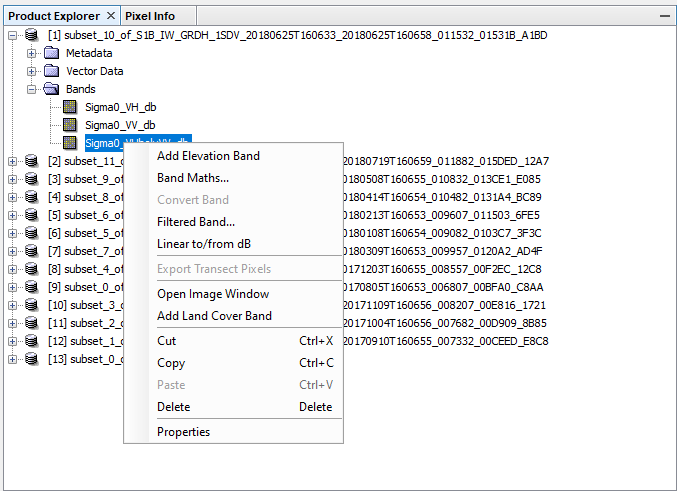I found this.
So do you suggest me working out the sigma 0 VV and VV dB ?
Post the centre coordinate of the field, and I will post back the backscattering signature for VV and VH. Looks like I was right about the growth stages.

Do you mean this?
No. The geographical coordinate(s) for the field location, i.e. either the center point or the polygon outlining it. Maybe you have it as KML in Google Earth, shape file in ArcMap, GML in QGIS, whatever.
Hello,
I am new in SAR image analysis. I want to create time series graph of different polarizations. (VV, VH, VH/VV, VH-VV etc.) I can only select VV or VH on the filter, but I want to create different combinations of VH and VV.
How can I create time series of VH/VV ratio? I already created VH/VV bands by using “Band maths” option but when I try to visualize backstatters of time series, only VH or VV options can be selected in the graph filter.
thanks in advance
if you create bands with band maths they are virtual in the first place (not written on your hard drive). Right-click > convert and then save your image by File > Save Product to have it permanently written. It will then be available in the time-series tool in the filter ![]() option.
option.
I haven’t tested it but I remember that I did something similar once.
Thank you, it worked.
One more thing, there is something I couldn’t understand. I read an article and its name is “Understanding the temporal behavior of crops using Sentinel-1 and Sentinel-2-like data for agricultural applications” by Amanda Velossa et al. They used VH/VV ratio but it seems they actually used VH-VV. See below:
How this can be possible? Am I missing something?
I have not read the article but I guess this is due to the relationship between linear and logaritmic
A ratio in linear is translated into a substraction in dB scale. Note that the figures in your post are in dB scale.
I hope this helps
Thank you very much to both of you.
In SNAP, does it possible to have a polygon’s mean backscatter value? My backscatter values are just a pin’s (pixel) value inside the polygon but all pixels have different values in the polygon. It would be more accurate analysis If I have mean backscatter values of a polygon, right?
I tried both importing as a shapefile and drawing a polygon as vector data but It doesnt work at all. It only visualizes the cursor’s backscatter values when the curser is on
cursor on
cursor off
any ideas?
you have to select the corresponding polygon with the normal mouse.
did you again select it in the filter dialogue?
yes sure, but still doesnt work. even if I select all bands, it is the same. It only works when the cursor on.
from your screenshot I see that it is still a virtual raster
Sorry but I dont understand what I need to do. How can I solve this problem? Could you tell me step by step?
I explained already above and based on your comments it worked: Sigma0 VH/VV analysis
![]() this indicates that your product is still virtual.
this indicates that your product is still virtual.
Are you sure that it is still virtual? Because I already converted it before and now I think it doesnt seem as virtual. When it is virtual, there would be “V” symbol on the band icon as below, isnt it?

but when I right click on my band, it is like this:
